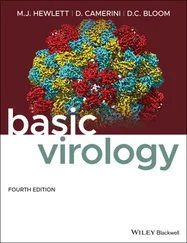Jane Flint - Principles of Virology
Здесь есть возможность читать онлайн «Jane Flint - Principles of Virology» — ознакомительный отрывок электронной книги совершенно бесплатно, а после прочтения отрывка купить полную версию. В некоторых случаях можно слушать аудио, скачать через торрент в формате fb2 и присутствует краткое содержание. Жанр: unrecognised, на английском языке. Описание произведения, (предисловие) а так же отзывы посетителей доступны на портале библиотеки ЛибКат.
- Название:Principles of Virology
- Автор:
- Жанр:
- Год:неизвестен
- ISBN:нет данных
- Рейтинг книги:3 / 5. Голосов: 1
-
Избранное:Добавить в избранное
- Отзывы:
-
Ваша оценка:
- 60
- 1
- 2
- 3
- 4
- 5
Principles of Virology: краткое содержание, описание и аннотация
Предлагаем к чтению аннотацию, описание, краткое содержание или предисловие (зависит от того, что написал сам автор книги «Principles of Virology»). Если вы не нашли необходимую информацию о книге — напишите в комментариях, мы постараемся отыскать её.
Volume I: Molecular Biology
Volume II: Pathogenesis and Control
Principles of Virology, Fifth Edition
Principles of Virology — читать онлайн ознакомительный отрывок
Ниже представлен текст книги, разбитый по страницам. Система сохранения места последней прочитанной страницы, позволяет с удобством читать онлайн бесплатно книгу «Principles of Virology», без необходимости каждый раз заново искать на чём Вы остановились. Поставьте закладку, и сможете в любой момент перейти на страницу, на которой закончили чтение.
Интервал:
Закладка:

Figure 3.3Structure and expression of viral gapped, circular, double-stranded DNA genomes. (A)Synthesis of genome, mRNA, and protein. (B)Configuration of the hepadnavirus genome.
RNA Genomes
Cells have no RNA-dependent RNA polymerases that can replicate the genomes of RNA viruses or make mRNA from RNA templates ( Box 3.3). One solution to this problem is that RNA virus genomes encode RNA-dependent RNA polymerases that produce RNA from RNA templates. The other solution, exemplified by retrovirus genomes, is reverse transcription of the genome to dsDNA, which can be transcribed by host RNA polymerase.
dsRNA (Fig. 3.5)
There are twelve families of viruses with linear dsRNA genomes. The number of dsRNA segments in the virus particle may be 1 ( Totiviridae, Hypoviridae , and Endornaviridae , viruses of fungi, protozoa, and plants); 2 ( Partitiviridae , Birnaviridae , and Megabirnaviridae , viruses of fungi, plants, insects, fish, and chickens); 3 ( Cystoviridae , viruses of Pseudomonas bacteria); 4 ( Chrysoviridae , viruses of fungi); or 10 to 12 ( Reoviridae , viruses of protozoa, fungi, invertebrates, plants, and vertebrates). While dsRNA contains a (+) strand, it cannot be translated to synthesize viral proteins as part of a duplex. The (–) strand of the genomic dsRNA is first copied into mRNAs by a viral RNA-dependent RNA polymerase. Newly synthesized mRNAs are encapsidated and then copied to produce dsRNAs.
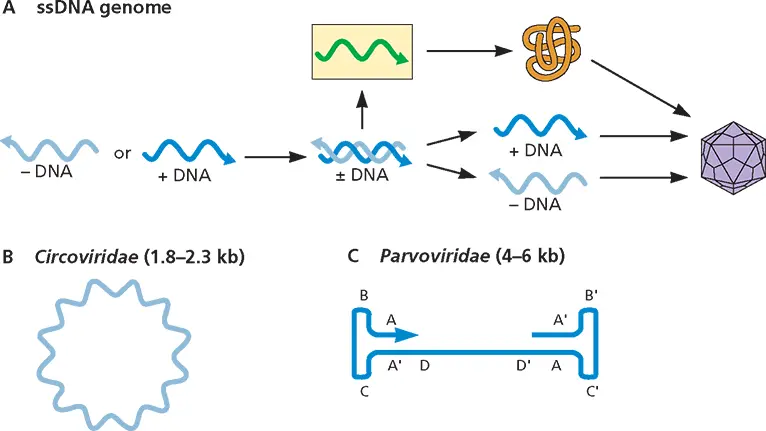
Figure 3.4Structure and expression of viral single-stranded DNA genomes. (A)Synthesis of genomes, mRNA, and protein. (B and C)Genome configurations.

Figure 3.5Structure and expression of viral double-stranded RNA genomes. (A)Synthesis of genomes, mRNA, and protein. (B)Genome configuration.
BOX 3.3
BACKGROUND
RNA synthesis in cells
There are no known host cell enzymes that can copy the genomes of RNA viruses. However, at least one enzyme, RNA polymerase II, can copy an RNA template. The 1.7-kb circular, ssRNA genome of hepatitis delta satellite virus is copied by RNA polymerase II to form multimeric RNAs (see the figure). How RNA polymerase II, an enzyme that produces pre-mRNAs from DNA templates, is reprogrammed to copy a circular RNA template is not known.
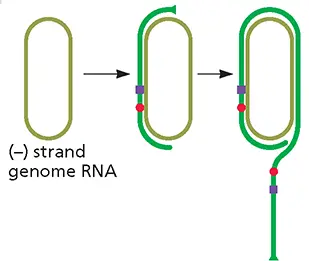
Hepatitis delta satellite (– ) strand genome RNA is copied by RNA polymerase II at the indicated position.The polymerase passes the poly(A) signal (purple box) and the self-cleavage domain (red circle). For more information, see Fig. 6.25Redrawn from Taylor JM. 1999. Curr Top Microbiol Immunol 239:107–122, with permission.
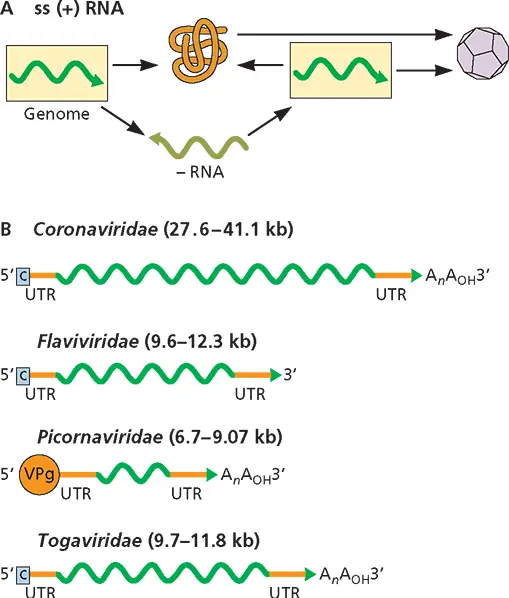
Figure 3.6Structure and expression of viral single-stranded (+) RNA genomes. (A)Synthesis of genomes, mRNA, and protein. (B)Genome configurations. UTR, untranslated region; VP g, virion protein, genome linked.
(+) Strand RNA (Fig. 3.6)
There are more different types of (+) strand RNA viruses than any other, and 38 families have been recognized [not counting (+) strand RNA viruses with DNA intermediates]. These genomes are linear and may be single molecules (non-segmented) or segmented, depending on the family. The families Arteriviridae , Astroviridae , Caliciviridae , Coronaviridae , Flaviviridae , Hepeviridae , Nodaviridae , Picornaviridae , and Togaviridae include viruses that infect vertebrates. (+) strand RNA genomes usually can be translated directly into protein by host ribosomes. The genome is replicated in two steps. The (+) strand genome is first copied into a full-length (–) strand, and the (–) strand is then copied into full-length (+) strand genomes. In some cases, a subgenomic mRNA is produced.
(+) Strand RNA with a DNA Intermediate (Fig. 3.7)
Members of four virus families are (+) strand RNA viruses with a DNA intermediate; those viruses within Retroviridae infect vertebrates. In contrast to other (+) strand RNA viruses, the (+) strand RNA genome of retroviruses is converted to a dsDNA intermediate by viral RNA-dependent DNA polymerase (reverse transcriptase). Following integration into host DNA, the viral DNA then serves as the template for viral mRNA and genome RNA synthesis by cellular enzymes.
( – ) Strand RNA (Fig. 3.8)
Viruses with (–) strand RNA genomes are found in 19 families. These genomes are linear and may be single molecules (nonsegmented; some viruses with this configuration have been classified in the order Mononegavirales ) or segmented. Viruses of this type that can infect vertebrates include members of the Arenaviridae , Bornaviridae , Filoviridae , Hantaviridae , Orthomyxoviridae , Paramyxoviridae , Pneumoviridae , and Rhabdoviridae families. Unlike (+) strand RNA, (–) strand RNA genomes cannot be translated directly into protein but must be first copied to make (+) strand mRNA. There are no enzymes in the cell that can make mRNAs from the RNA genomes of (–) strand RNA viruses. These virus particles therefore contain virus-encoded RNA-dependent RNA polymerases. The genome is also the template for the synthesis of full-length (+) strands, which, in turn, are copied to produce (–) strand genomes.
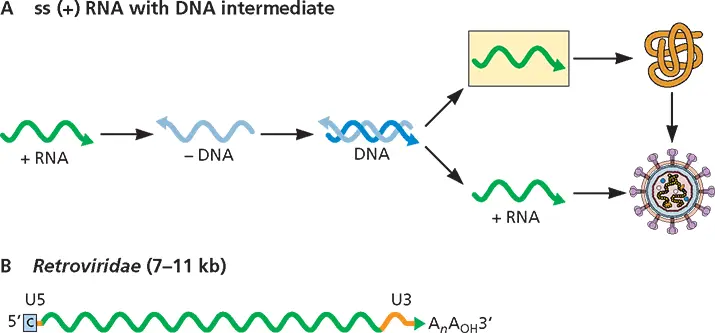
Figure 3.7Structure and expression of viral single-stranded (+) RNA genomes with a DNA intermediate. (A)Synthesis of genomes, mRNA, and protein. (B)Genome configuration.
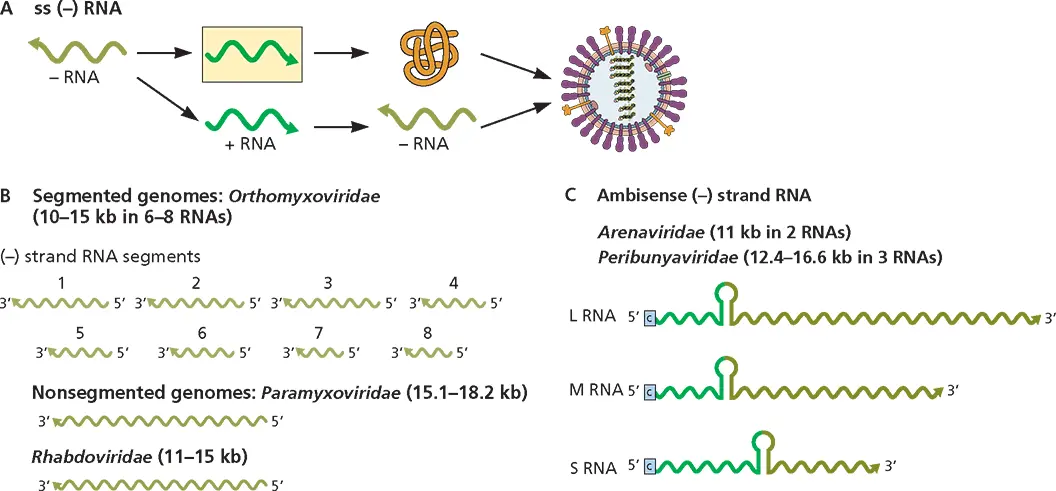
Figure 3.8 Structure and expression of viral single-stranded (–) RNA genomes. (A)Synthesis of genomes, mRNA, and protein. The icon represents an orthomyxovirus particle. (B and C)Genome configurations.
The genomes of certain (–) strand RNA viruses (e.g., members of the Arenaviridae and Bunyaviridae ) are ambisense: they contain both (+) and (–) strand information on a single strand of RNA ( Fig. 3.8C). The (+) sense information in the genome is translated upon entry of the viral RNA into cells. Replication of the RNA genome yields additional (+) sense sequences, which are then translated.
Читать дальшеИнтервал:
Закладка:
Похожие книги на «Principles of Virology»
Представляем Вашему вниманию похожие книги на «Principles of Virology» списком для выбора. Мы отобрали схожую по названию и смыслу литературу в надежде предоставить читателям больше вариантов отыскать новые, интересные, ещё непрочитанные произведения.
Обсуждение, отзывы о книге «Principles of Virology» и просто собственные мнения читателей. Оставьте ваши комментарии, напишите, что Вы думаете о произведении, его смысле или главных героях. Укажите что конкретно понравилось, а что нет, и почему Вы так считаете.





